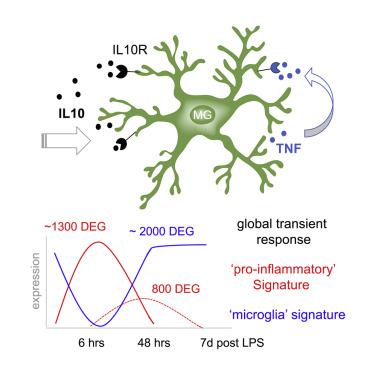Immunity ( IF 32.4 ) Pub Date : 2020-10-12 , DOI: 10.1016/j.immuni.2020.09.018 Anat Shemer , Isabelle Scheyltjens , Gal Ronit Frumer , Jung-Seok Kim , Jonathan Grozovski , Serkalem Ayanaw , Bareket Dassa , Hannah Van Hove , Louise Chappell-Maor , Sigalit Boura-Halfon , Dena Leshkowitz , Werner Mueller , Nicola Maggio , Kiavash Movahedi , Steffen Jung

|
Microglia, the resident macrophages of the brain parenchyma, are key players in central nervous system (CNS) development, homeostasis, and disorders. Distinct brain pathologies seem associated with discrete microglia activation modules. How microglia regain quiescence following challenges remains less understood. Here, we explored the role of the interleukin-10 (IL-10) axis in restoring murine microglia homeostasis following a peripheral endotoxin challenge. Specifically, we show that lipopolysaccharide (LPS)-challenged mice harboring IL-10 receptor-deficient microglia displayed neuronal impairment and succumbed to fatal sickness. Addition of a microglial tumor necrosis factor (TNF) deficiency rescued these animals, suggesting a microglia-based circuit driving pathology. Single cell transcriptome analysis revealed various IL-10 producing immune cells in the CNS, including most prominently Ly49D+ NK cells and neutrophils, but not microglia. Collectively, we define kinetics of the microglia response to peripheral endotoxin challenge, including their activation and robust silencing, and highlight the critical role of non-microglial IL-10 in preventing deleterious microglia hyperactivation.
中文翻译:

白细胞介素10预防周围内毒素挑战后病理小胶质细胞过度活化。
小胶质细胞是脑实质的常驻巨噬细胞,是中枢神经系统(CNS)发育,体内稳态和疾病的关键因素。不同的脑部病理似乎与离散的小胶质细胞激活模块有关。挑战后小胶质细胞如何恢复静止尚不清楚。在这里,我们探讨了白细胞介素10(IL-10)轴在外周内毒素挑战后恢复小鼠小胶质细胞稳态中的作用。具体来说,我们表明脂多糖(LPS)挑战的小鼠窝藏IL-10受体缺陷小胶质细胞显示神经元损伤和屈服于致命疾病。小胶质细胞肿瘤坏死因子(TNF)缺乏症的补充救出了这些动物,表明基于小胶质细胞的电路驱动病理。+ NK细胞和嗜中性粒细胞,但不包括小胶质细胞。我们共同定义了小胶质细胞对周围内毒素挑战的动力学,包括其激活和强大的沉默,并突出了非小胶质细胞IL-10在防止有害小胶质细胞过度活化中的关键作用。


























 京公网安备 11010802027423号
京公网安备 11010802027423号